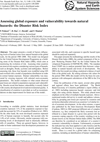Resource
Assessing global exposure and vulnerability towards natural hazards: the Disaster Risk Index
Description
This paper presents a model of factors influencing levels of human losses from natural hazards at the global scale, for the period 1980–2000. This model was designed for the United Nations Development Programme as a building stone of the Disaster Risk Index (DRI), which aims at monitoring the evolution of risk. Assessing what countries are most at risk requires considering various types of hazards, such as droughts, floods, cyclones and earthquakes. Before assessing risk, these four hazards were modelled using GIS and overlaid with a model of population distribution in order to extract human exposure. Human vulnerability was measured by crossing exposure with selected socio-economic parameters. The model evaluates to what extent observed past losses are related to population exposure and vulnerability. Results reveal that human vulnerability is mostly linked with country development level and environmental quality. A classification of countries is provided, as well as recommendations on data improvement for future use of the model.